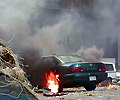The Athabaskan Indians were hunters and inland fisherman. They traveled for days without food and existed in temperatures of -45°C / -50°F or less without shelter or fire. Some Athabaskan groups inhabited permanent winter villages and summer fishing camps.



The Russians came to Alaska in the early 1800's. They converted Athabaskan Indians to Russian Orthodox religion. Many of the religious practices of natives and the Russians blended. One of the most interesting are spirit houses found in the Eklutna Cemetery. They contain personal items to help the spirit in the next life. Each family uses specific colors for their spirit house to identify their clan. There are no written names. The three-bar Orthodox cross placed in the foot of the grave identifies members of the Russian Orthodox Church.
Pacific Coast Indians (groups identified today as the Tlingts and Haidas) had a great respect for the natural world. Every hunted animal was treated with honor. For example, they always returned all bones to the river where salmon was caught.
The totem poles carved by Coastal Indians trace the history of individual native families and clans. They are like a family crest or family tree. Each figure on the pole is a symbol of a family characteristic, an event, or a totem - a power of nature to which the family has a special relation. From the many portrayed figures, Thunderbird is the most powerful spirit. It perches at the highest point.


The ideal tree for carving is a western red cedar that grows close to the sea or a river, so it is easy to transport. Unfortunately, cedar posts rot after about 65 years, so few old poles remain standing.
The Inupiaq settled in Arctic region. Their village sites were chosen for availability of food sources like seal, walrus, whale and polar bear. The Inupiaq people have not had a written system for centuries. The only way to pass knowledge from one generation to another was through stories and songs. Their culture was different that European. They had a completely different sense of property rights. Individual clans had rights to selected dances, for example, but land was common.



Skin whaling boats called umiak are still used for hunting sea animals in spring. The one shown on a picture is covered with walrus skin. The old culture of the north seems to be still alive. Whaling is still legally practiced by Inupiaq families despite strict international regulations. They are also allowed to hunt polar bear. The Inupiaq language is spoken from northeastern Siberia to Greenland. It is one of the most complex and difficult languages in the world. This is proven by the fact that apparently no European trader or explorer has ever been able to speak the language fluently.
The name "Eskimo" that probably comes from the French word esquimaux meaning "one who nets snowshoes” was commonly used to describe the indigenous peoples of the Arctic and subarctic regions of North America and northern Russia. However, it has a controversial history and is now considered unacceptable by many, largely because it was imposed by newcomers and has a racist history. Native Alaskans prefer other terms. The most common is "Inuit," which simply means "people," but names from their own languages, such as Inupiaq or Yupik, more accurately describe individual ethnic groups. "Inuit" is now the proper term for the indigenous peoples of the Arctic.




